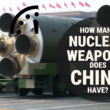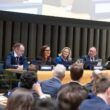Toward a transformed treaty
By Adel M. Ali, May 17, 2012
Countries without nuclear weapons tend to focus much attention on nuclear weapon states’ failure to achieve the disarmament that the Nuclear Non-Proliferation Treaty (NPT) requires them to pursue. Nuclear weapon states, meanwhile, focus on the fact that access to peaceful nuclear technology, which the treaty guarantees to all nations, carries with it the potential for weapons proliferation.
That such access might lead to proliferation is indeed a serious concern — but one should bear in mind that when states have illicitly acquired nuclear weapons in the past, they have not relied on civilian nuclear power facilities to do so. North Korea and Israel used research reactors to develop their weapons capabilities. Pakistan also developed its weapons capability apart from the civilian fuel cycle, while the fissile materials for India's nuclear weapons are believed not to have been derived from power production reactors.
Still, some — including Naeem Ahmad Salik in this Roundtable — have proposed that multilateral arrangements be established to manage the nuclear fuel cycle. But these proposals suffer from serious flaws. First, multilateral arrangements for the fuel cycle may simply fail to address true proliferation risks — as indicated above, past cases of proliferation have not grown out of the civilian use of nuclear energy. Second, uranium enrichment and plutonium reprocessing are not proscribed under the NPT. A non-nuclear weapon state does nothing illicit merely by possessing enrichment or reprocessing technologies or even by possessing weapons-grade nuclear material.
Therefore, if multilateral approaches to the fuel cycle are to be implemented, they must be structured so as not to infringe on any state’s right to reach its own decisions regarding the fuel cycle. And crucially, no supplier country should be able to hamper or interrupt for political reasons any nation’s peaceful nuclear undertakings.
Universally recognized. If it is true that multilateral arrangements for the fuel cycle cannot ultimately prevent proliferation, these arrangements’ primary function would seem to be enhancing the nonproliferation regime. But if that is the goal, better means to do so exist. For example, non-member states could be brought into the treaty as non-nuclear weapon states through the establishment of nuclear-weapon-free zones in the Middle East and South Asia, and on the Korean peninsula. Salik objects to this idea, saying that "Israel would be offered something in return for disarming — recognition of its right to exist, security assurances — [but] no such quid pro quo is in the offing where India and Pakistan are concerned." Such objections could be addressed if the treaties establishing nuclear-weapon-free zones were structured along the lines of Africa’s Treaty of Pelindaba. That treaty’s first and second protocols are designed to prevent the use or threat of use of nuclear weapons against signatories; that and other assurances included in the protocols would contribute meaningfully to security if applied in South Asia.
Salik, however, proposes establishing an additional protocol to the NPT whereby India, Israel, and Pakistan would take on the obligations accepted by other nuclear weapon states in return for acceptance of their status as nuclear weapon states. My view is that such an approach would, first, run counter to the 2010 NPT Review Conference, which called on all states that are not parties to the treaty to accede as non-nuclear weapon states. Second, it would contradict the spirit of the treaty itself, which after all is intended to prevent the proliferation of nuclear weapons to states that do not have them, while achieving disarmament in the states that do have them. Third, it would weaken and could even bring about the end of the NPT regime. States outside the regime must be convinced that their entry into the treaty is the only hope of stopping further proliferation; their remaining outliers, or insisting on acceptance as nuclear weapon states, not only invites further proliferation but ultimately threatens the collapse of the treaty regime itself.
Among the most notable characteristics of today’s nonproliferation regime is that different levels of effort are expended toward nonproliferation and disarmament. Indeed, many non-nuclear weapon states are convinced that the only way to stop proliferation is to address disarmament and nonproliferation with equal vigor. When in 2000 the parties to the treaty committed themselves to an "unequivocal undertaking" to rid the world of nuclear weapons, their intent was to transform the NPT into a treaty truly focused on disarmament and nonproliferation. That transformation must now proceed.
Topics: Nuclear Energy, Nuclear Weapons
Share: [addthis tool="addthis_inline_share_toolbox"]














